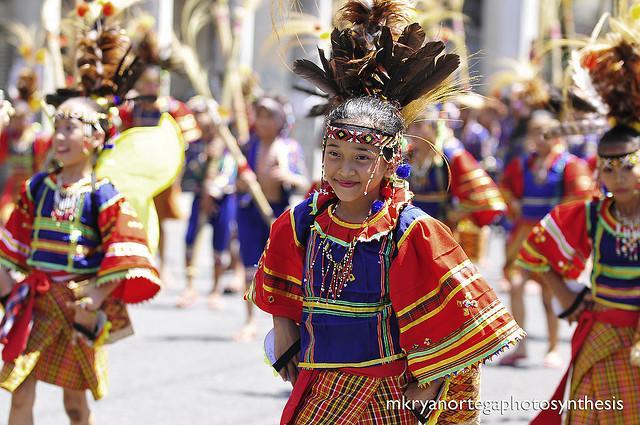
Davao City takes pride in its rich culture, traditions, and beliefs. The rich cultural diversity of the province is mirrored through their festivals. The colorful and lively festivals of the city are one of the major attractions of the tourists. One highlight is the Kadayawan Festival celebrated every August.
What Kadayawan means?
Kadayawan is derived from the friendly greeting "Madayaw", from the Dabawenyo word "dayaw", meaning good, valuable, superior, or beautiful.

What is the origin of the festival?
Legends said Davao's ethnic tribes residing at the foot of Mount Apo unite during a bountiful harvest. This ritual serves as their thanksgiving to the gods, particularly to the “Manama” or “the Supreme Being”.
Fruits, flowers, vegetables, rice, and corn grains are displayed on mats as villagers give their respect and thanks for the year's abundance. Singing, dancing, and offering to their divine protectors are the highlights of this ritual.
Through the years, this practice of thanksgiving or "pahinungod" is still very much practiced by modern day of Davaoeños. This tradition flourished and evolved into an annual festival of thanksgiving.

How did it become Kadayawan Festival?
In the 1970’s, Mayor Elias B. Lopez, a Bagobo, initiated tribal festivals featuring the Lumad and the Muslim tribes of Davao City where they showcase their dances and rituals of thanksgiving.
Later in 1986, a program called "Unlad Proyekto Davao" was initiated by the government which was aimed to unite the Dabawenyos after the turbulent Martial Law era. At that time, the festival was called "Apo Duwaling," a name created from the famous icons of Davao: Mt. Apo, the country's highest peak; Durian, the king of fruits; and Waling-waling, the queen of orchids.
“Apo Duwaling” was meant to showcase the city as a peaceful destination to visit and to do business after 1986 EDSA Revolution.
Finally in 1988, City Mayor Rodrigo Duterte renamed the festival as "Kadayawan sa Dabaw" to celebrate the bountiful harvest of Davao’s flowers, fruits, and other produce as well as the wealth of the city’s cultures. To this day, the festival continues to honor the city's richness and diverse artistic, cultural, and historical heritage in a grand celebration of thanksgiving for all of Davao City's blessings.

Why it is dubbed as the Festival of Festivals?
Kadayawan has transformed into a festival of festivals, with a number of spin-off festivals in the region. The festival is a celebration of life, a thanksgiving for the gifts of nature, the wealth of culture, the bounties of harvest, and serenity of living.
It honors Davao’s artistic, cultural and historical heritage, its past personified by the ancestral Lumad people. A celebration that interfaces the three aspects: tribal, industrial, and arts and entertainment. The festivities are highlighted with floral floats, street-dancing competitions, and exhibits that showcase the island's tourism products and services.
How to Get There
By air: Davao City has direct flights to major cities in the Philippines and some Asian cities. The Francisco Bangoy International Airport serves the general area of the city and its surrounding areas.
By sea: Davao is connected to Manila by a series of roll-on roll-off or inter-island ferry connection.
Getting around: The common modes of public transportation in Davao are multicabs, jeepneys, tricycles, buses, and taxis. Multicabs and jeepneys ply 82 designated passenger vehicle routes around the clock. Tricycles ply the routes that are outside the main streets of the city. Taxis have several routes in and outside Davao City. In mountainous areas, the habal-habalpassenger motorcycle is the main mode of transportation.
Accommodation
- Marco Polo Davao Hotel- CM Recto Street, Davao City Center, Davao, Philippines 8000
- The Royal Mandaya Hotel- J. Palma Gil Street, Davao City Center, Davao, Philippines 8000
- Apo View Hotel- 150 J Camus Street, Davao City Center, Davao, Philippines 8000
- The Metropolis Suites Davao - Cabaguio Avenue, Corner Macopa Street, Davao City Center, Davao, Philippines 8000
- Hotel Vicente - Florentino Torres Street, Davao City Center, Davao, Philippines 8999
- Pinnacle Hotel and Suites - Sta. Ana Avenue, Davao City Center, Davao, Philippines
- Casa Leticia Boutique Hote - Jose Camus Street, Davao City Center, Davao, Philippines 8000
- The Ritz Hotel at Garden Oases - Porras Street, Bo. Obrero, Davao City Center, Davao, Philippines 8000
- Grand Men Seng Hote - Magallanes-Anda Streets, Davao City Center, Davao, Philippines 8000
- Anisabel Suites - 888 FS Dizon Road, Bacaca, Davao City Center, Davao, Philippines










